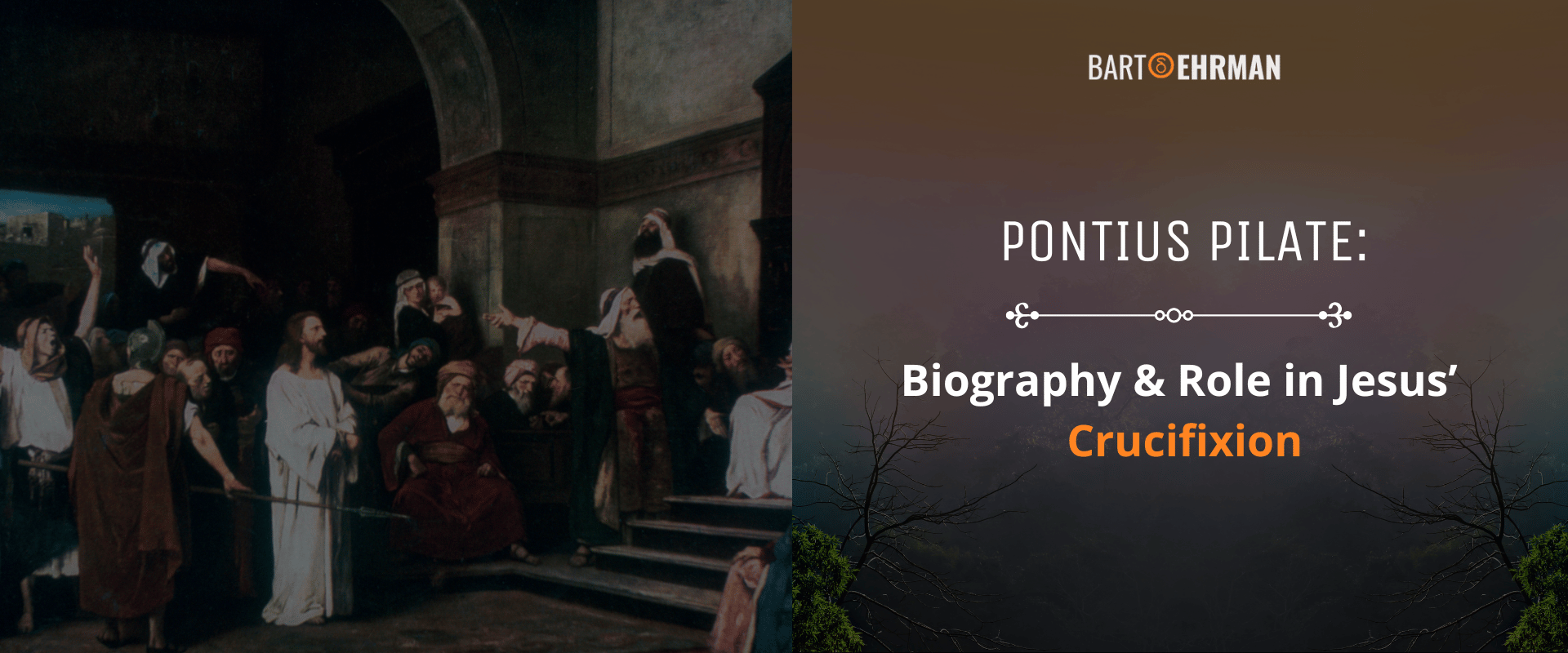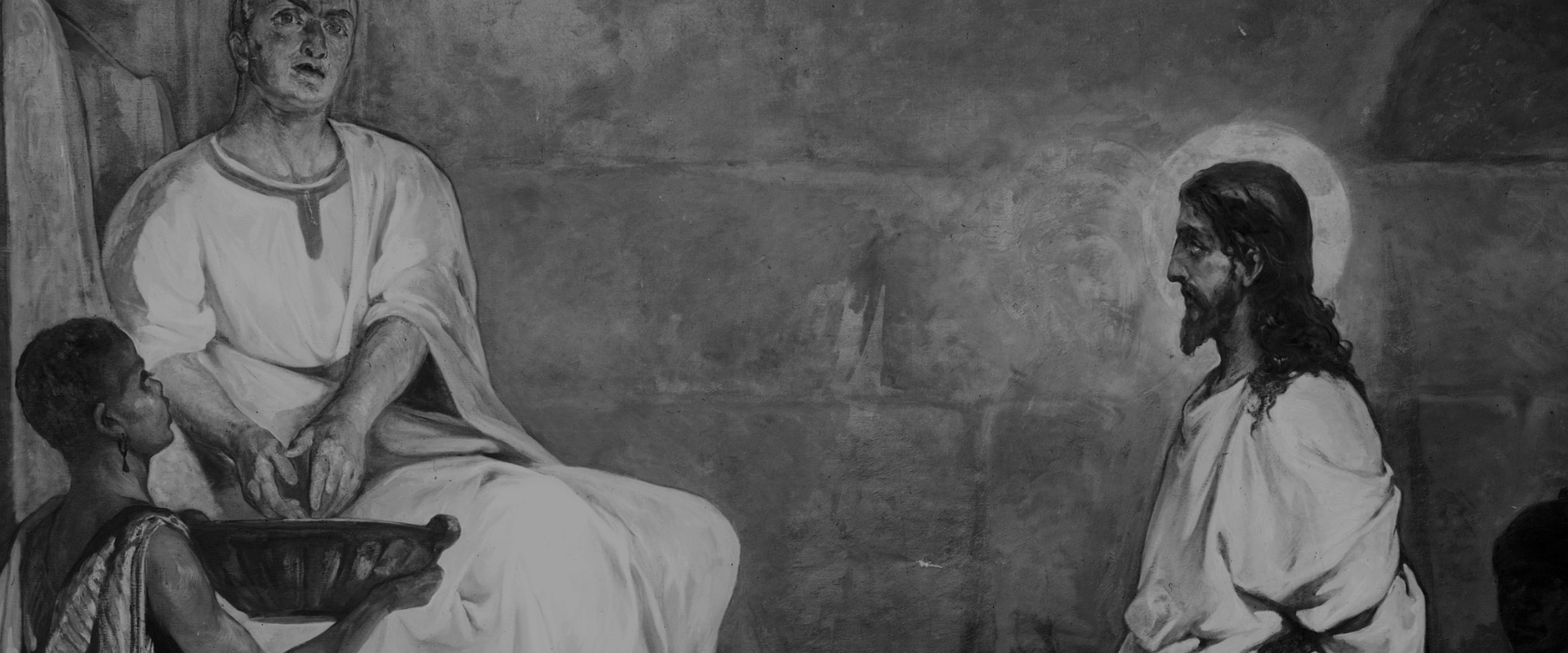Pontius Pilate: Biography & Role in Jesus’ Crucifixion

Written by Joshua Schachterle, Ph.D
Author | Professor | Scholar
Author | Professor | BE Contributor
Verified! See our editorial guidelines
Verified! See our guidelines
Edited by Laura Robinson, Ph.D.
Date written: October 4th, 2024
Disclaimer: The views and opinions expressed in this article belong to the author and do not necessarily match my own. - Dr. Bart D. Ehrman
Pontius Pilate is a name that echoes through centuries of religious and historical discourse, largely due to his pivotal role in the crucifixion of Jesus. But what do we really know about Pilate? Are the Gospel portrayals of him accurate?
In this article I’ll examine the life of Pontius Pilate, exploring his historical background, his governance, and the portrayals of him in Christian texts throughout history. Furthermore, I’ll uncover the reality behind this key biblical figure to understand how historical and theological perspectives have intertwined to influence his reputation.

Who Is Pilate in History?
It would be wonderful to have a complete biography of Pontius Pilate, but the information from ancient sources about him is fairly sparse. For this reason, we don’t know anything about Pilate’s early life with certainty, although some scholars think his name might give us some clues about his background.
Roman naming conventions generally used three names for upper-class males: the praenomen, analogous to our modern first names, the nomen, a family name or surname, and the cognomen, a third name which was used by wealthy, high-status Romans to refer to each other according to J.G.F. Powell. For example, the Roman orator and statesman Marcus Tullius Cicero would merely have been addressed as Cicero. Accordingly, Pontius Pilate is referred to as “Pilate” in most of our sources.
Pilate’s name (Latin: Pontius Pilatus) does not include his praenomen in our sources. In his book Pontius Pilatus, Alexander Demandt writes that Pilate’s cognomen might refer to skill with a javelin which is pilum in Latin. If this is the case, it could indicate that Pilate’s father acquired this cognomen by proving his military skill. Alternatively, Demandt says the name could refer to a cap called a pileus, which might indicate that one of Pilate’s ancestors was a freed slave. (Affiliate Disclaimer: We may earn commissions on products you purchase through this page at no additional cost to you. Thank you for supporting our site!)
“Pontius,” Pilate’s nomen, suggests his family came originally from a region called Samnium in central, southern Italy. He may, therefore, have come from the family of two leaders of that region, Gavius Pontius and Pontius Telesinus.
In Pontius Pilate in History and Interpretation, Helen Bond writes that Pilate was a member of the equestrian order, mid-rank status in Roman society. While not at the top of the social order, he would nevertheless have been wealthy and educated. As a member of the Roman nobility, he was likely married, but our only reference to his wife, in Matthew 27:19, is not historically credible, according to both Bond and Demandt. Furthermore, it is highly likely, according to Bond, that Pilate had a military career before becoming a governor, although we have no explicit evidence of this.
Governor of the Roman Province of Judea
In his Antiquities of the Jews, 1st-century Jewish historian Josephus says that Pilate was governor of Judea for ten years during the reign of the emperor Tiberius, who reigned from 14-37 CE. Helen Bond says that Pilate was governor from 26-36/37 CE. His official title was “prefect,” and Bond notes that this title implies that his duties were military in nature.
While his main residence as governor would have been in Caesarea, the administrative capital of the Roman province of Judea, he would have come to Jerusalem for major festivals to help maintain order. One of Pilate’s rights as governor of Judea, by the way, was to appoint the High Priest of the Jerusalem Temple. Pilate appointed and retained Joseph ben Caiaphas as High Priest for his entire tenure. Readers of the Gospels will no doubt recognize this name from the accounts of Jesus’ trial (for example, Matthew 26:56–67).
During his tenure as governor of Judea, Pilate had several major conflicts with the people under his rule. In The Jewish War and Antiquities of the Jews, Josephus writes that, early in his tenure, Pilate ordered Roman military standards — decorative signs often carried into battle — with pictures of the Roman emperor on them to be brought into Jerusalem. Joan Taylor notes that Pilate was trying to promote the imperial cult, in which emperors were worshiped as gods. This, of course, would have caused major friction since Jews believed in their God alone and prohibited worship of other gods.
Josephus says that, in protest, groups of Jews surrounded Pilate’s house for five days. Pilate had them summoned to an arena and then had his soldiers draw their swords threateningly. However, Josephus says that the protestors were willing to die for their cause and that Pilate, aware that a large, bloody incident might reflect badly on him, agreed to remove the standards.
In another confrontation recorded by Josephus, Pilate used the funds from the Temple treasury to build an aqueduct to Jerusalem. An angry crowd thus surrounded Pilate while he visited Jerusalem. Josephus says
Now when [Pilate] was apprized aforehand of this disturbance, he mixed his own soldiers in their armor with the multitude, and ordered them to conceal themselves under the habits of private men, and not indeed to use their swords, but with their staves to beat those that made the clamor… Now the Jews were so sadly beaten, that many of them perished by the stripes they received, and many of them perished as trodden to death by themselves.
In addition to these two egregious incidents, Helen Bond notes that "it is not only possible but quite likely that Pilate's governorship contained many such brief outbreaks of trouble about which we know nothing." In Embassy to Gaius, 1st-century Jewish philosopher Philo of Alexandria writes about Pilate’s
corruption, and his acts of insolence, and his rapine, and his habit of insulting people, and his cruelty, and his continual murders of people untried and uncondemned, and his never-ending, and gratuitous, and most grievous inhumanity.
In short, Pilate was not a benevolent governor and certainly had a terrible reputation among the Jews he was governing. Having established this historical background for Pilate, let’s look at his portrayal in the four canonical Gospels.
By the way, our one Roman source about Pilate is a brief mention by Roman historian Tacitus, writing about 80 years later, who merely acknowledges that Jesus was killed under his governorship.
Who is Pilate in the Bible?
In Mark, our oldest written Gospel, we first encounter Pilate in the Bible when Jesus is brought before him for trial. He first asks Jesus if he is the king of the Jews, a charge brought by the chief priests. In Mark 15:2 Jesus answers enigmatically “You say so.” When the chief priests continue to charge him with crimes, Jesus is silent, despite Pilate’s gentle prodding.
Next, Pilate offers to release one Jewish prisoner to commemorate Passover. Mark says this was a common practice but historians beg to differ. In fact, Bart Ehrman notes that apart from the Gospels, there is no evidence that Pilate or any other Roman governor ever did this. In addition, given Pilate’s brutal nature as I outlined above, it seems highly unlikely. In any event, Pilate brings out Jesus and another prisoner named Barabbas. The crowd calls out for Barabbas to be released and for Jesus to be crucified. In Mark 15:14-15, Pilate seems to be defending Jesus and asks
“Why, what evil has he done?” But they shouted all the more, “Crucify him!” So Pilate, wishing to satisfy the crowd, released Barabbas for them, and after flogging Jesus he handed him over to be crucified.
In other words, Pilate doesn’t want to crucify Jesus, but the demands of the crowds force his hand. Based on what we’ve seen of Pilate’s pitiless methods of crowd control, this portrayal of a sympathetic Pilate doesn’t add up.
Matthew, who used Mark as one of his sources, writes essentially the same story, adding a detail in which Pilate conspicuously washes his hands in front of the crowd, signifying that while he allows Jesus to be crucified, he is not responsible. Again, this is not realistic. Luke adds that Pilate sent Jesus to be judged by King Herod who then sent him back to Pilate. Pilate pleads Jesus’ innocence to the crowd but then acquiesces to their demands and allows him to be crucified.
Finally, in the Gospel of John, Pilate has much more of a dialogue with Jesus. This convinces him even more that Jesus is innocent but, as he is fearful of the bloodthirsty crowd, he meekly hands Jesus over to be crucified.
What all these portrayals have in common is a timid, fearful Pilate who acquiesces to the demands of the people he is governing. Josephus and Philo would certainly not have agreed with these depictions of Pilate.
Most scholars agree that the Gospel portrayal of Pilate is inaccurate. John Meier, for instance, notes that Josephus writes that Pilate alone condemns Jesus to be crucified. Later Christian scribes added material to Josephus’ quote, but this particular fact is generally held to be authentic. Brian McGing argues that it is far more likely that Pilate simply executed Jesus as an insurrectionist without hesitation. So why would the Gospels portray Pilate this way?
In Lost Christianities: the Battle for Scripture and the Faiths We Never Knew, Bart Ehrman argues that while Mark shows the Jews and Pilate to be in agreement about killing Jesus, later Gospels gradually decrease Pilate's liability. He argues that this change is due to increasing separation between Christianity and Judaism over decades and demonstrates a kind of anti-Judaism. In The Death of the Messiah: From Gethsemane to the Grave, Raymond Brown agrees, saying that these mild portrayals of Pilate reveal later contrasts between Jews and Christian Jews using anti-Jewish polemics.

What Happened to Pilate After Jesus Died?
To further reinforce the ruthless reputation Pilate had in his time, Josephus writes that in 36 or 37 CE, one further violent incident proved to be Pilate’s downfall as governor. An armed group of Samaritans, an ethnic and religious group closely related to the Jews, went to a small village near Mount Gerizim, where they hoped to find artifacts buried by Moses. Suspecting a revolt of some kind, Pilate had many of them slaughtered, although some escaped and fled. Those who survived complained to Lucius Vitellius the Elder, the governor of Syria and Pilate’s superior, that they had been unarmed and thus massacred without cause. Vitellius had Pilate summoned to Rome to be judged before Emperor Tiberius.
By the time Pilate arrived in Rome, however, Tiberius had died and been replaced as emperor by Caligula. We have no information about the outcome of Pilate’s meeting with Caligula, but it is certain that Pilate was either removed as governor or chose not to return. At this point, Pilate disappears from history.
However, unlike some biblical figures, Pontius Pilate’s existence is supported by at least one authentic archeological discovery. At the ruins of the ancient city of Caesarea in 1961, archeologists found what is now called the Pilate stone, a block on which the following fragmentary inscription can be read:
To the Divine Augusti Tiberieum
...Pontius Pilate
...prefect of Judea
...has dedicated
Scholars have surmised that the stone was to be part of a Temple dedicated by Pilate to the emperor Tiberius dated to 26-36 CE. This is tangible evidence of Pilate’s existence and his time as governor of Judea.
Later Christian Portrayals of Pilate
We’ve already noted that the Pilate of the Gospels was portrayed as timid and mild-mannered, contrasting with other sources. We’ve also seen that with the passage of time, Pilate’s was made to appear more and more innocent of Jesus’ death. That trend continued in the following centuries.
Tertullian, a 2nd-century Christian author, for example, said he had seen Pilate's report to Tiberius, and said Pilate had "become already a Christian in his conscience.” Most scholars believe this claim to be false.
In the 4th century, apocryphal gospels were written, some of which exonerated Pilate completely for Jesus’ death. The Gospel of Peter, for instance, says that Pilate had no involvement at all in Jesus’ death, which was actually done by the king Herod Antipas. The Gospel of Nicodemus (also called the Acts of Pilate) says Pilate was compelled by the Jews to crucify Jesus but felt very distressed about it. There are also two “reports” supposedly written by Pilate and sent to Tiberius about Jesus' death and resurrection, blaming the Jews.
In a Greek text called The Handing Over of Pilate, written in the 5th century CE, Pilate is arrested and brought to Rome to be tried before Tiberius for executing Jesus, although he has since converted Christianity. He is condemned, and at his execution, a heavenly voice says he will be with Jesus at the Second Coming.
Additionally, the Ethiopian Orthodox Church actually recognizes Pilate as a Christian saint.
Conclusion
Pontius Pilate was the governor of the Roman province of Judea from 26-36/37 CE. This happened to coincide with the arrest of Jesus, and Pilate accidentally became a permanent part of Christianity’s history.
The Nicene Creed, the 4th-century statement of faith composed at the council of Nicaea, mentions Pilate by name, saying that Jesus “was crucified for us under Pontius Pilate.” This was probably done to reinforce the notion that the crucifixion really did happen in history, but it also immortalized Pilate.
Sources outside the Bible say Pilate was cruel, not hesitating to violently punish anyone who stood in his way. In addition, there is no historical evidence that Pilate cared about the Jews or their beliefs and practices.
Despite this, the Gospels portray Pilate almost as an innocent bystander to Jesus’ death, blaming the Jews instead, which has caused centuries of antisemitism and ignored the facts of history. Later Christian writings even portrayed Pilate as a saintly Christian who suffered tremendous guilt over his role in the death of Jesus.
It almost certainly wasn’t true, though. Pilate was responsible for Jesus’ death. As Bart Ehrman says, the real Pilate was “offensive, intransigent, and brutal.”


